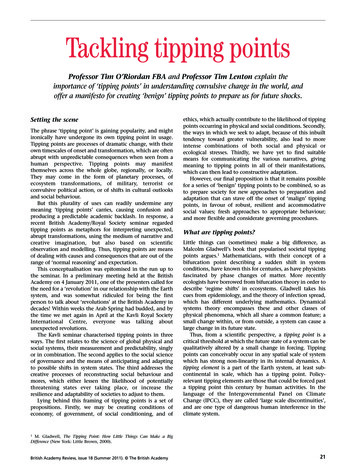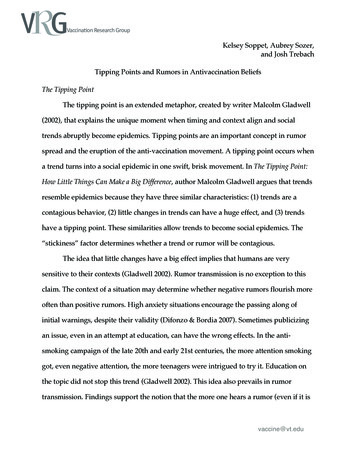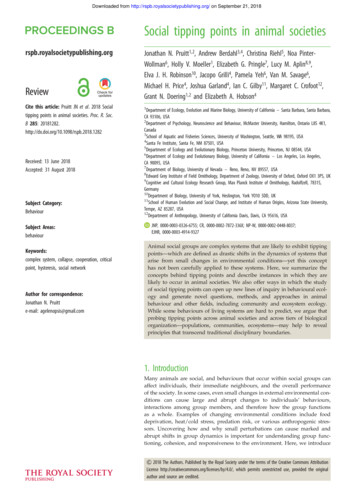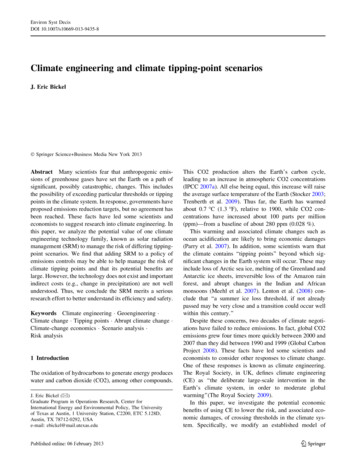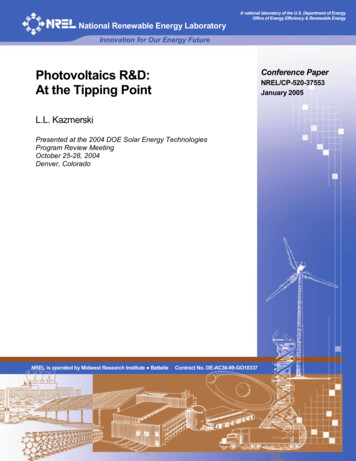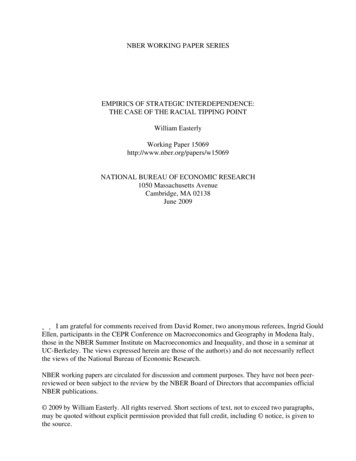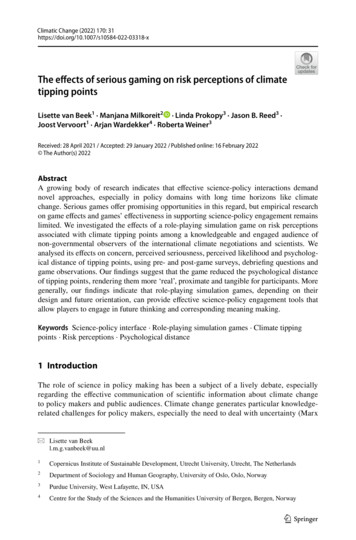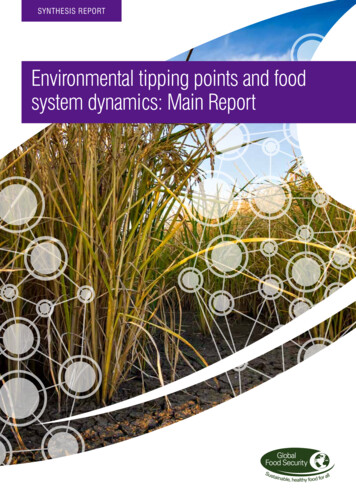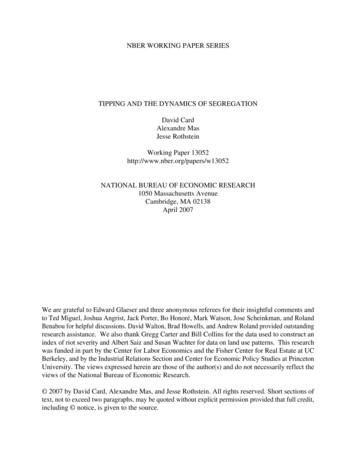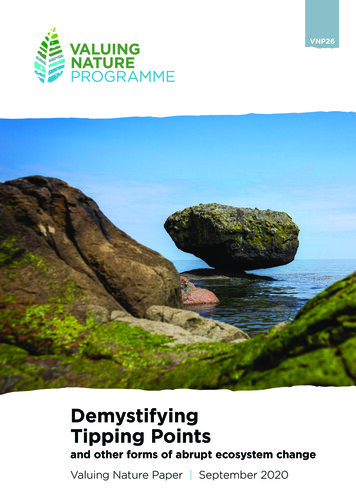
Transcription
VNP26DemystifyingTipping Pointsand other forms of abrupt ecosystem changeValuing Nature Paper September 2020
DemystifyingTipping Pointsand other forms of abrupt ecosystem changeValuing Nature Paper September 2020Editor: Guy Duke, Director, GD NatCap Ltd and Business Champion for theValuing Nature Programme Coordination Team.What this paper doesThis paper aims to demystify the concept ofthe ‘tipping point’ — the phenomenon whereby,beyond a certain threshold, runaway changepropels a system to a new state. It introducestipping points as applied to the climate system,ecosystems (and the services they supply) andsocio-ecological systems. It then considers whatcauses tipping points in ecosystems and providesexamples of tipping points in ecosystems andtheir services. Finally, it addresses the applicationof evidence on tipping points and other forms ofabrupt ecosystem change in policy and practice.This paper is targeted largely at policy-makersand practitioners involved in safeguarding andrestoring nature, who may be well placed toaddress tipping points, but not necessarilywell versed in the science of tipping points.2Valuing Nature Paper Demystifying Tipping Points
Introducing tipping pointsThe concept of the tipping point has become widely applied since the turn ofthe century, in relation to social behaviour, the climate system, ecosystemsand, more recently, natural capital and ecosystem services and social-ecologicalsystems. This short paper sets out to demystify the concept. It aims to aidunderstanding of tipping points and other abrupt changes, in particular inecosystems and their services, and their relevance to societies and economies,with a view to helping decision-makers in government, business and civilsociety frame appropriate precautionary measures and responses.Tipping points in the spread of ideas and behaviourIn his popular book, The Tipping Point: How Little Things Can Make aBig Difference, published in 2000, Malcolm Gladwell explained howideas, trends and social behaviour spread like epidemics, and whichfew elements need to come together to help an idea reach the point ofcritical mass, where its exponential viral effect becomes unstoppable.The tipping point is the point at which this criticalmass is reached, where an idea goes from beinginteresting to a few, to a must-have for everyone.For example, Instagram, following steady earlygrowth, reached a tipping point in early 2012 when,all of a sudden, the entire world seemed to need anaccount. In socio-economic contexts, this virus-likegrowth is not limited to the Internet. It happenedpreviously, for example, with the fax machine andwith the use of car seat belts.Figure 1. T he recent rise ofthe term ‘tipping point’in the scientific literature.(Source: ISI Web of Science). The red lineshows the number of articles that are labelledwith the research field ‘environmental scienceand ecology’. Source: van Nes et al. 2016.Reprinted from Nes et al. (2016)with permission from Elsevier.While the term ‘tipping point’ was in use prior toGladwell’s book, the book prompted an exponentialrise in its use in the scientific literature (Figure 1),in particular in relation to climate science,environmental sciences and ecology.Valuing Nature Paper Demystifying Tipping Points3
Tipping points in the climate systemFollowing this popular notion that little things can make a big difference –that, at a particular moment in time, a small change can have large, long-termconsequences for a system – the term ‘tipping point’ is now frequently appliedin discourse on climate change. Here, human activities resulting in greenhousegas emissions may have the potential to push components of the Earth systempast critical states into qualitatively different modes of operation, implyinglarge-scale impacts on human and ecological systems.A tipping point in the climate system has been defined as‘ the critical point at which the future state of the system is qualitativelyaltered by a small perturbation’ (Lenton et al. 2008).Potential tipping points have been identified both in the physical climatesystem itself, and in ecosystems affected by climate change. For example drierclimates can lower peatland water tables, leading to irreversible changes in theirability to store soil carbon or support specialist species of plants and animals.The precise levels of climate change sufficient to trigger any given tipping pointremain uncertain, but the risk associated with crossing multiple tipping pointsincreases with rising temperature.Large-scale components of the Earth system that may pass a tipping pointas a result of climate change have been referred to as tipping elements(Lenton et al. 2008). These tipping elements include, for example, decay ofthe West Antarctic and Greenland ice sheets, loss of permafrost and tundraand boreal forest dieback, dieback of the Amazon rainforest and changes inocean currents, notably, the Atlantic thermohaline circulation (THC) andthe El Niño-Southern Oscillation (ENSO) (Figure 2).IncreasedtemperaturesFigure 3:A positive feedback example —the climate systemreduced albedo effect(i.e. reduced reflection ofsolar radiation by snowand ice away fromEarth’s atmosphere)4increasedice meltValuing Nature Paper Demystifying Tipping PointsNot all such tipping points areabrupt. For example at some levelof temperature rise, the melt of alarge part of the Greenland and/or West Antarctic Ice Sheets willbecome inevitable, but the icesheets themselves may persist formany centuries. This inevitabilityis driven by positive feedback.Critically, some tipping points –in both the physical climate systemand in ecosystems – are irreversible.Figure 3 provides an example ofthis positive feedback.
Figure 2. Map of potential policy-relevant tipping elements in the climate system,overlain on global population density.Subsystems indicated could exhibit threshold-type behaviour in response to anthropogenic climate forcing, where a smallperturbation at a critical point qualitatively alters the future fate of the system. They could be triggered this century andwould undergo a qualitative change within this millennium. Question marks indicate systems whose status as tippingelements is particularly uncertain. Source: Lenton et al. (2008). Copyright 2008 National Academy of Sciences.Valuing Nature Paper Demystifying Tipping Points5
Tipping points in ecosystems and other forms ofabrupt ecosystem changeApplied to ecosystems, the term tipping point has been used loosely as ametaphor for the phenomenon that, beyond a certain threshold, runaway changepropels a system to a new state (van Nes et al. 2016). More precisely, it refers toany situation where accelerating change caused by a positive (i.e. self-enforcing)feedback drives an ecosystem to a new state, with significant changes inbiodiversity, natural capital and/or ecosystem services. An example of sucha positive feedback is provided in the Figure 4.Deforestationincreasedfire riskreducedregional rainfallFigure 4:A positive feedback example —ecosystemsfurther dryingincreasedfire riskfurther forestdieback6Valuing Nature Paper Demystifying Tipping Points
It is the existence of a positive feedback process that drives acceleratingchange that differentiates the concept of a tipping point from other formsof abrupt ecosystem change. Together, tipping points and these otherforms of abrupt change can be referred to as ecological thresholds.An ecological threshold is the point at which a relatively small, endogenouschange, or an external disturbance to the system, leads to an abrupt changein an ecosystem quality, property or phenomenon (Groffman et al. 2006).Ecological thresholds represent a non-linearity of the responses in ecological orbiological systems to pressures caused by human activities or natural processes.It is worth stressing here that the term ‘tipping point’ refers to a specifictype of ecological threshold, where the abrupt change is driven by a positivefeedback mechanism. Tipping points are of particular concern, in comparisonwith other forms of ecological threshold, because, as a result of the positivefeedback, a small environmental change can push a system ‘over a cliff’,resulting in accelerating change over time. This has been particularlydocumented, for example, in small lakes.Tipping points are challenging to identify for ecosystems because thefeedback mechanisms are hard to identify and to test. However, this doesnot mean that they are not happening. The collapse of food webs inagricultural land indicated by the recently recorded declines in insectnumbers, farmland birds and bats might be a good example of this –a tipping point that might be happening that we are not fully aware of.While identifying tipping points and other types of ecological thresholdscan be challenging in practice, evidence increasingly indicates thatnonlinear threshold responses could be widespread (Watson et al. 2018).Changes in ecosystems that take place once a tipping point has beenreached can be long lasting and hard to reverse, or may be irreversible.Often, there is a significant time lag between the pressures drivingthe change and the appearance of impacts, creating difficulties inecological management.Valuing Nature Paper Demystifying Tipping Points7
Tipping points in socio-ecological andsocio-economic systemsRecent research on social-ecological systems (SES) (e.g. Milkoreit et al. 2018)has contributed to the growth and definition of the use of the term ‘tipping point’in integrated systems in which humans are part of nature. Consisting of bothhuman societies and the environment, SES can exhibit sudden and unexpectedchanges that could have significant impact on natural capital stocks (NC) andthe flows of ecosystem services (ES) essential for people and their wellbeing(Biggs et al. 2012). A decline in natural asset stocks (or ‘assets’) can result inan abrupt decline in the flow of ecosystem services and the value of thebenefits that arise from these services (Figure 5).The term ‘tipping point’ has also been applied to climate-driven abrupt change insocio-economic systems, such as the collapse of winter sports tourism, farmlandabandonment and sea-level rise-induced migration (van Glinkel et al. 2020).Figure 5. T ipping points in natural capital.Anthropogenic pressures, such as land cover change, pollution or climate change, can leadto a change in the condition or state of an ecosystem. These changes can happen abruptly,representing an ecological threshold. Where such thresholds are caused by a positive feedbackmechanism, they are referred to as tipping points. Source: Newton et al. 2019.Historic StateEcological threshold or tipping pointsresuesPre.g. climate change,nitrogen depositionChanged StateLoss of biodiversityLess provision of most ecosystem servicesNegative impacts on the economyDecline in human well-being8Valuing Nature Paper Demystifying Tipping Points
What causes ecosystemsto reach tipping points?Tipping points in complex systems have sometimes been interpretedas equivalent to critical transitions, phase transitions or fold bifurcations(Lenton et al., 2008, Scheffer et al., 2009; Ashwin et al., 2012). Such conceptsderive from theories of dynamical systems, including bifurcation andcatastrophe theories.Application of these theories has highlighted a number of ways in whichtipping points can occur, as a result of change in the external conditionsof a system, or a change in the intrinsic properties of the system itself(Ashwin et al., 2012, van Nes et al., 2016).According to these theories, the mechanisms that cause tipping pointshave been classified into three different categories: bifurcation-, rateand noise-induced tipping. These are illustrated in Figure 6.Here, the basic concept is that the possible state(s) of the system are representedas well(s) or valley(s), separated by a hilltop. The ball then represents the currentstate of the system, which at equilibrium resides in one of the wells. In thisfigure, the ‘potential landscape’ refers to the complete shape of wells and hilltops– the term derives from mathematics and can be used to describe the underlyingdynamics of the system. For all types of tipping, we can consider the same startposition: two wells separated by a hilltop with the ball in the left well.In the case of bifurcation tipping, a smooth change in an external parameter(e.g. nutrient input) causes an ecosystem’s current state to lose stability overtime (the valley gets shallower), until it reaches a point at which the statebecomes unstable, causing an abrupt shift to a new, alternate, steady state.This is represented in Figure 6 (a) in which the well the system originallyoccupies (left-hand well, dashed line) slowly deforms and shallows, indicatingthat the ecosystem state is becoming more untenable as the tipping point isapproached. At the tipping point the well disappears (red line, left-hand side)leaving the ball no other option but to fall into the other well, representingsome new alternative stable steady state. Bifurcation tipping points canbe detected by the use of early warning signals (van Nes et al. 2016).Valuing Nature Paper Demystifying Tipping Points9
Figure 6: Bifurcation, rate- and noise-induced tipping points.(a), (b) bifurcation; (c), (d) rate-induced and (e), (f ) noise-induced. Figures (a), (c) and (e) displaythe potential landscape before tipping (black-dashed lines) and after tipping (coloured solid lines),were the ball represents the current state of the system. Figures (b), (d) and (f ) sketch possibletimes series data (coloured) overlaid on a diagram of the stable (black solid) and unstable(black dashed) states. Reproduced by permission, Copyright 2020 Paul Ritchie.10Valuing Nature Paper Demystifying Tipping Points
Such bifurcation tipping points are often termed catastrophic and irreversiblebecause of a phenomenon known as hysteresis, meaning that the system cannotbe restored by retracing the same path. Rather, the external parameter that forcedthe tipping must be pushed back significantly further than the threshold valuethat caused the tipping.In the case of rate-induced tipping, the potential landscape itself shifts.This is represented in Figure 6 (c) in which the ball (representing the stateof the ecosystem) is forced to move up the side of the well as it lags behind theshift in landscape (in this case, from right to left), struggling to adapt to thechanging conditions. With a sufficiently fast rate of change, tipping occurs,as the system is no longer able to adapt and transitions over the ‘hilltop’ tothe alternative stable state (the right-hand well).In the case of noise-induced tipping, Figure 6 (e), the shape and position ofthe well remains constant. It requires a large perturbation (e.g. a major pollutionevent), or a series of perturbations in the same direction (e.g. successive mortalityevents in a population) to cause the ball (the state of the ecosystem) to traversethe ‘hilltop’ and shift to the alternative stable state. Because noise-inducedtipping points involve unforeseeable perturbations, rather than a gradual changein the stability of the system, their timing cannot be forecast using indicators(van Nes et al. 2016), although their likelihood can be assessed.Most tipping points are a combination of bifurcation and noise induced tipping,such that less noise is needed to cause tipping when closer to a bifurcation.While these theoretical ideas are well developed mathematically, and havesuccessfully been applied to climate and to some ecosystems, their relevanceto understanding dynamics in other ecosystems is still the subject of debate(Newton 2021).Examples of tipping points inecosystems and their servicesEvidence of tipping points now exists at local to global scales, across decadalto centennial time scales for many subsystems of the Earth, including theclimate system. Similar shifts linked to ecosystems have been documentedin social, political and economic domains (Biggs et al. 2012). Boxes 3 and 4provide examples of tipping points in ecosystems and their ecosystem servicesfrom the UK and beyond.Valuing Nature Paper Demystifying Tipping Points11
Box 1: E cological and socio-economic tippingpoints in UK peatlandsThe Valuing Nature Programme’s Peatland Tipping Points project lookedat a range of socio-economic and policy drivers that could trigger tippingpoints in ecosystem services, and changes in ecosystem function thatmight trigger abrupt changes in the use of and value placed on peatlandsby different stakeholders.The project identified two potential tipping points linked to changesin land management and climate change. First, a significant increasein upland grazing (e.g. as a result of increased policy emphasis on UKfood self-sufficiency) could lead to an abrupt and potentially irreversiblereduction in peat accumulation. Second, climate change may lead to yearswhere there are very few Tipulids (crane flies or daddy longlegs) whichcould lead to a crash in populations of ground nesting birds (notablyGolden Plover Pluvialis apricaria), which rely on these insects as prey.The project also investigated whether changes in peatland condition mightlead to tipping points or abrupt changes in the way people use and valuepeatlands. The research found strong support for rewetting and restorationof damaged peatlands in England (80% of those surveyed in the NorthPennines), based on climate, water, wildlife, culture and economic benefits.However, rewetting could lead to abrupt changes in patterns of recreationaluse, with walkers and cyclists less keen on the more boggy conditions andplacing a negative value on restored bogs.The project also found that a payment of 100/ha/year might be sufficientto trigger a behavioural tipping point in terms of widespread uptake bylandowners of peatland restoration schemes. Research with stakeholderssuggest that such a level of payment would reflect the full value offully functioning peat bog – including values relating to local history,biodiversity, freedom and tranquillity.12Valuing Nature Paper Demystifying Tipping Points
Box 2: E xample of tipping points in a globallydistributed ecosystem: kelp forestsKelp forests are found along 25% of the world’s coastlines, wherethey engineer their surrounding ecosystems and provide an abundanceof food sources. They provide multiple ecosystem services includingfishing, tourism, coastal protection and climate control, estimatedto be worth US 0.5 – 1.0 million/km2.However, 38% of kelp forests worldwide have declined over the past50 years. Kelp forests can be driven to collapse, becoming dominatedby ‘turf’ algae. This smaller, less structured vegetation does notprovide the same wealth of ecosystem services. Drivers towards thisturf-dominated state include gradual warming, eutrophication andpollution and invasive species.In most cases, significant kelp loss is observed before temperature-inducedmortality alone would cause loss, suggesting a combination of stressorsdrive the collapse. For example, increased temperatures increase thegrowth of epiphytes which coat the kelp in encrusting colonies, eventuallyreducing kelp tissue strength. In addition, abrupt events, such as heatwaves and overharvesting, may help push the system into the turf state.In the kelp-dominated state, feedback loops such as kelp shading andmechanical abrasion limit the growth of other vegetation. However, thesefeedback loops weaken with the warming-induced gradual loss of kelp.The subsequent growth of turf algae establishes different feedback loopswhich favour further turf growth and inhibit kelp growth.It is to be expected that ecosystem services supplied by kelp forests arerelated in a more-or-less linear manner to the health of the ecosystem.A tipping point collapse in these services is therefore likely to parallela tipping point in the kelp ecosystem itself.Valuing Nature Paper Demystifying Tipping Points13
Addressing tipping points inpolicy and practiceWhy TPs are of concern1 tsTipping points are a major concern because of their potentially large and oftenirreversible impacts on climate and biodiversity, on natural capital stocks andecosystem service flows, and thereby on socio-economic systems and humanwell-being. It can be extremely difficult for societies to adapt to abrupt andpotentially irreversible shifts in the functioning and character of ecosystemsand the related ecosystem services on which they depend 1.Evidence is mounting that tipping points could be more likely than was thought,have high impacts and are interconnected across different biophysical systems,potentially committing the world to long-term irreversible changes.Figure 7: R aising the alarm.Evidence that tipping points are under way has mounted in the past decade.Domino effects have also been proposed. Source: Lenton et al. 2019.14Valuing Nature Paper Demystifying Tipping Points
Of particular concern are the feedbacks between climate change and land –as highlighted by the recent IPCC Special Report on Climate Change and Land(Jia et al. 2019). The interconnectedness of the Earth’s biophysical systems couldlead to cascading effects with a tipping point in one major system increasingthe likelihood of a tipping point in others (Figure 7). The evidence fromtipping points alone suggests that we are in a state of planetary emergencyrequiring urgent further international action (Lenton et al. 2019).Making appropriate use of the evidenceThe concept of ecological thresholds has significantly aided our capacity topredict the controls over ecosystem structure and functioning (Selkoe et al. 2015).Evidence of tipping points and other forms of abrupt ecosystem change –both those that have occurred, and those predicted to occur through modelling –can and should be influential in shaping public policy and decision-making.Evidence on tipping points and ecological thresholds is equally relevant tothe private sector, in terms of security of supply chains and physical assets.Evidence might be applied to inform corporate risk registers and/or in thecourse of natural capital assessments which provide information on impactsand dependencies on natural assets. A key issue for the private sector is thatof permanence in carbon and ecosystem markets. Tipping points and otherecological thresholds have the potential to undermine the credibility of thesemarkets if they lead to abrupt changes in the provision of ecosystem servicesthat landowners are contractually obliged to provide to investors.Evidence can be applied to pre-empt tipping points and other formsof ecological threshold and, where feasible, to restore ecosystems thathave passed ecological thresholds.The appropriate response to an approaching or apparent ecologicalthreshold differs depending on what the driver of change is, and onwhether or not the threshold represents a true tipping point involvinga positive feedback mechanism.An ecological threshold could be caused by a driver (e.g. climate change)intensifying in a non-linear way. In this case, one would need apolicy response to address the change in the driver.Valuing Nature Paper Demystifying Tipping Points15
However a tipping point is driven by an internal feedback within the ecosystem,often interacting with a change in an external driver. So, the appropriate policyresponse might include addressing this internal feedback, and/or the externaldriver. To return to our previous example of positive feedback, reduced rainfalldue to climate change might lead to increased fire risk and forest dieback,leading to further drying and further increase in fire risk and so furtherforest dieback. In this case, reducing fire risk is an appropriate short-termpolicy response, thereby interrupting the internal feedback mechanism.Addressing climate change is also an appropriate policy response, but itseffectiveness is inherently longer-term.2 Biodiversa (nd) Measures toincrease ecosystem resilienceand avoid tipping points.www.biodiversa.org/policybriefsAvoiding predicted tipping points and other forms of ecologicalthreshold involves enhancing the resilience of ecosystems. Research cancharacterize tipping points for specific ecosystems, identify indicators tomonitor these ecosystems, and suggest management strategies to enhanceresilience. For example, recent research in Europe has done this forforest and pond ecosystems. 2Dealing with uncertainty in tipping point evidenceTipping point evidence – whether past tipping points or modelled predictions– involves uncertainty. As for all natural phenomena, the evidence may involvetwo kinds of uncertainty (van der Bles et al. 2019). One is known as aleatoryuncertainty due to the fundamental randomness of the world (‘aleatory’means ‘random’). This generally relates to future events, which we can’t knowfor certain – such as the timing of a future tipping point and the alternatestate of an ecosystem that might follow.A second kind of uncertainty, known as epistemic uncertainty, involvesuncertainty about the facts, numbers or science. This generally, but not always,relates to past or present phenomena that we currently don’t know, but could,at least in theory, know or establish – such as the precise cause of a tippingpoint that has already happened, and how the change might be reversed.Modelling the future risks of tipping points can also contain a strong element ofepistemic uncertainty, in that further knowledge would revise our predictions.This uncertainty is not unique to tipping points science. All knowledge onwhich decisions and policies are based is shrouded with epistemic uncertainty,of various types and degrees.In interpreting evidence around tipping points, it is important to clarifywhat the uncertainty relates to (e.g. the hypothesis, and/or the numbers involved)and why is there uncertainty (e.g. because of unavoidable natural variation,difficulties of measuring, and/or limited knowledge about the underlyingprocesses) (van der Bles et al. 2019).16Valuing Nature Paper Demystifying Tipping Points
Scenarios are a common way of communicating uncertainty relating totipping points. Different scenarios may be based on different assumptions toexpress epistemic uncertainty. Aleatory uncertainty or randomness may bemodelled to show a range of plausible outcomes based on our understandingof underlying processes, which can be represented as alternative scenarios.As with other areas of science, care should be taken to avoid drawing policyrecommendations from single tipping point studies and to synthesize evidenceacross multiple studies instead, e.g. using meta-analysis and other formsof evidence synthesis. This proviso applies equally to restoration measures toredress the passing of ecological thresholds – see Box 3 for an example ofthis from the Peatlands Tipping Points project.Box 3: A n example of using evidence across multiple studiesto inform policy and practiceThe Peatland Tipping Points project tackled the challenge of how to measure the effects ofrestoration, given that it is currently very difficult to combine measurements from studiesin different sites to understand the effects of management or restoration at national scales.Measurements from individual sites may provide conflicting evidence about the effect ofrestoration on carbon, water or wildlife. The researchers worked across the peatlandcommunity to agree a core set of variables that should be measured across as many researchand monitoring projects as possible. The hope is that this will lead to more standardized datathat can be synthesised to generate more evidence-based policy and practice in future.Limits to understanding and the need forprecautionary approach3 tsOur understanding of how basic abiotic and biotic drivers interact to alter thevalues of ecosystem services and benefits as tipping points are reached andexceeded, remain limited. The dynamics in most cases cannot yet be predictedwith enough precision and advance warning to allow for specific and targetedapproaches to avoid them, or to mitigate their impacts. Responsible riskmanagement therefore requires a precautionary approach to human activitiesknown to drive ecosystem change.3Further, care should be taken in shaping policy simply with a view to avoidingtipping points and other forms of ecological threshold. If we wait to seeclear tipping points or other forms of ecological threshold in response toanthropogenic pressures, we risk overlooking the gradual and cumulativedegradation of the environment. This again points to the need to apply theprecautionary principle in minimising damage to ecosystems.Valuing Nature Paper Demystifying Tipping Points17
ReferencesBiggs, D., Hall, C.M., Stoeckl, N. 2012. The resilience of formal andinformal tourism enterprises to disasters: reef tourism in Phuket, Thailand.Journal of Sustainable Tourism 20(5), 645 – 665.Gladwell, M. 2000. The tipping point: how little things can make a big difference.Little, Brown.Groffman, P.M., Baron, J.S., Blett, T. et al. 2006.Ecological thresholds: the key to successful environmental managementor an important concept with no practical application? Ecosystems 9, 1 – 13.Jia, G., Shevliakova, E., Artaxo, P., De Noblet-Ducoudré, N. et al. 2019:Land–climate interactions. In: Shukla, P.R., Skea, J., Calvo, E. et al. (eds.)Climate Change and Land: an IPCC special report on climate change,desertification, land degradation, sustainable land management, food security,and greenhouse gas fluxes in terrestrial ecosystems. In press.Lenton, T. M., Held, H., Kriegler, E. et al. 2008.Tipping elements in the Earth's climate system. PNAS 105(6), 1786 – 1793.Lenton, T.M., Rockstrom, J., Gaffney, O. et al. 2019.Climate tipping points – too risky to bet against. Nature 565, 592 – 595.Milkoreit, M., Hodbod, J., Baggio, J. et al.
A tipping point in the climate system has been defined as 'the critical point at which the future state of the system is qualitatively altered by a small perturbation' (Lenton et al. 2008). Potential tipping points have been identified both in the physical climate system itself, and in ecosystems affected by climate change. For example drier
